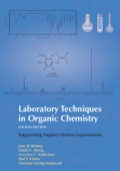
Interpretation:
The reason for the better efficiency of GC than fractional distillation should be stated.
Concept introduction:
Gas chromatography is efficiently used for the compounds that have high vapor pressures which allow them to pass through a GC column.
A gas chromatography does not identify compounds if unknown samples are loaded into the column. GC is one of type of partition chromatography, where the sample that has to be analyzed gets adsorbed on the stationary phase.
The stationary phase is formed by high boiling nonvolatile liquid, usually a
The components of gas-liquid chromatography are as follows:
- High-pressure pure carrier gas source
- Flow controller
- Heated injection port
- Column and column oven
- Detector
- Recording device or data station
Explanation of Solution
The separation of mixtures during gas chromatography is due to the interaction of compounds present in the mixture in different ways with the liquid stationary phase.
A GC column is composed of thousands of theoretical plates which result in a huge surface area on which the gas and liquid phases can interact. The partition of a substance between the liquid and gas phases is based on its relative affinity to the liquid phase and its vapor pressure. The higher is the vapor pressure, the greater is its tendency to go from the liquid stationary phase into the mobile gas phase.
As the substances rise up in the GC column, thousands of liquid-gas equilibria take place. A low boiling compound remains in gas phase for longer time than a high boiling compound.
Generally, compounds that have low boiling points have high vapor pressures. So they rise through a GC column faster than compounds that have high boiling points.
In the case of fractional distillation, the number of theoretical plates is less than 10 so the surface is in comparison to GC is less for interaction between the gas and liquid phases. This leads to poor separation of compounds.
Want to see more full solutions like this?
Chapter 20 Solutions
EBK LABORATORY TECHNIQUES IN ORGANIC CH
- You are carrying out an experiment by analysing alcoholic drinks by gas chromatography. Why is Gas chromatography the best technique used for this analysis? Why is Carbowax a suitable stationary phase for this analysis? What gases are used and what is their purpose and source?arrow_forwardWhat is the main drawback of using steam distillation in the isolation of volatile oils from its matrix?arrow_forwardWhat is the purpose of derivatization in chromatography? Give an example.arrow_forward
- Compare simple and fractional distillation for the separation of HEXANE and TOLUENEarrow_forwardWhat are the functions and procedure of analysis of many volatile organic molecules by using Gas chromatographyarrow_forwardChromatography is a separation technique. What is the physical or chemical basis for separation of compounds during thin layer chromatography?arrow_forward
- Is thin-layer chromatography a type of normal-phase chromatography or a type of reverse-phase chromatography? Define these two classifications.arrow_forwardExplain why does TLC and paper chromatography is normal phase chromatography?arrow_forwardsamples collected during distillation were kept in a fridge for a week before being analyzed by GC. Explain what would be different about the GC analysis results if they were kept out on a shelf in lab instead. Refer to each fraction collected.arrow_forward
- What are desirable properties of a gravimetric precipitate?arrow_forwardUse a suitable model to explain how separation and identification of a mixture of organic compounds can be achieved with a thin layer chromatographic (TLC) technique.arrow_forwardQuestion: What is the effect of mobile phase composition on the separation efficiency of a reversed-phase chromatography system for the analysis of complex pharmaceutical mixturesarrow_forward
 Macroscale and Microscale Organic ExperimentsChemistryISBN:9781305577190Author:Kenneth L. Williamson, Katherine M. MastersPublisher:Brooks Cole
Macroscale and Microscale Organic ExperimentsChemistryISBN:9781305577190Author:Kenneth L. Williamson, Katherine M. MastersPublisher:Brooks Cole
